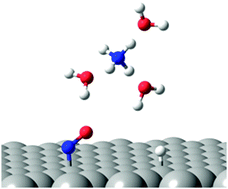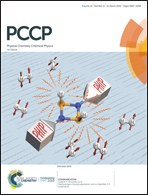A computational study on the electrified Pt(111) surface by the cluster model†
Abstract
A hemispherical cuboctahedral Pt37 cluster is applied to study NO adsorption and reduction on the Pt(111) surface by using density functional theory. The neutral charge and the constant potential methods are studied with a focus on the site dependence. This cluster model can represent the qualitative features of NO adsorption on the Pt(111) surface in accordance with the relevant experimental results. Moreover, the constant potential method combined with the implicit solvation model CPCM (conductor-like polarizable continuum model) can render proper predictions on the potential-dependent reactivities of the electrochemical reactions on the Pt(111) surface. This combined method suggests that the surface intermediates HNO and NOH are more stable at higher and lower potentials, respectively, during NO reduction on the Pt(111) surface. The relevant activation energies of this elementary step in the Langmuir–Hinshelwood mechanism suggest that HNO is more favorable in the kinetics than NOH. The corresponding formation of the N–H and O–H bonds in the Eley–Rideal mechanism are studied with potential dependence. Moreover, NOH is not a stable species, in contrast to HNO, in aqueous solution according to the predicted pKa and the potentials of the one-electron NO reduction in the standard state. Their relevant properties on the Pt(111) surface of the Pt37 cluster are studied. Finally, the possible reaction pathway of NO reduction to NH4+ on the Pt(111) surface is discussed.



 Please wait while we load your content...
Please wait while we load your content...